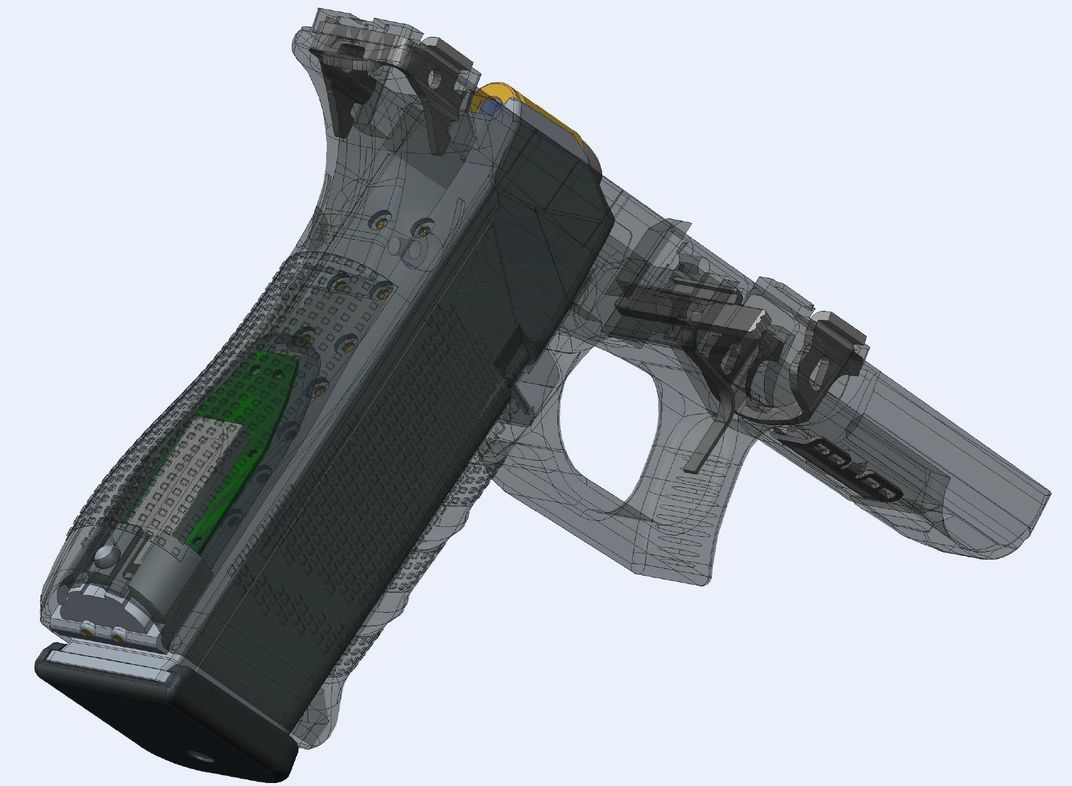A Sensor In Guns Tells Dispatch When Police Officers Need Backup
By monitoring the position and status of firearms, commanders can see exactly what’s happening in the field
/https://tf-cmsv2-smithsonianmag-media.s3.amazonaws.com/filer/d6/35/d635420b-4c90-49b1-a60e-9fda875c92ff/yardarm_sensor_on_the_table.jpg)
Controversy is the fruit of unclear facts, especially when law enforcement is involved. Take the Michael Brown shooting in Ferguson, Missouri, for example. Officials spent weeks after the incident trying to piece together exactly what happened—how many shot were fired, by whom and from where. And still we may never know what transpired with total certainty.
The increased adoption of technology in law enforcement is meant to help clear up many of these questions. Dashcams, for instance, now provide evidence when eyewitness accounts and officer reports don’t jibe; they’re mandatory equipment in some states, including New Jersey.
California startup Yardarm Technologies is out to take things a step further. They’ve developed a compact sensor that, when placed inside a firearm, will track the gun’s location, position, when it’s fired and when it’s unholstered. In addition to adding an extra layer of factual evidence, the sensor will allow dispatchers to more carefully monitor officers’ safety in the field. The company began field trials with S.W.A.T. teams in Santa Cruz, California, and Carrollton, Texas, last month.
The sensor is about the size of a matchbook and slides easily inside the grip of a Glock sidearm. It contains a battery, accelerometer, magnetometer (or compass), gyroscope, processor and Bluetooth radio. Together, these components can determine whether or not the gun is in an officer’s holster, which direction it’s pointing, where and when shots are fired and whether or not an officer has been separated from his or her firearm. There’s currently no limit to how many firearms the system can monitor at once. Data syncs with Yardarm’s cloud servers through the officer’s smartphone, and dispatchers and commanders can view a readout in real time.

One of the goals of the trials, which will run for the next several months, is to refine how and when the system will alert dispatchers of incidents, explains James Schaff, Yardarm’s vice president of marketing. “An officer might unholster his firearm dozens of times, but each time isn’t [necessarily] a critical moment,” he says. The trials, which encompass about 12 officers in each department, will help set rules in the software and establish two-way communication with dispatch. For instance, if the system knows that an officer is out on a call, backup will be called immediately if his or her gun is drawn.
The ultimate goal is to use telemetry data from firearms to respond to incidents quickly and ensure safety at the scene. "A law enforcement leader’s ultimate responsibility is to keep their staff and the public safe at all times,” Santa Cruz County Sheriff Phil Wowak said in a statement. “Yardarm's technology is a groundbreaking way to do just that.”
Yardarm hasn’t always been well-received. When the company first launched in March 2013, its primary goal was to develop a smart gun for consumers, featuring a remote kill switch and location tracking. While gun-safety advocates embraced the concept, a spokesperson for the National Rifle Association called the costs for the technology “a luxury tax on self defense,” fearing broad regulation that would require all guns to be made smart perhaps before the systems were completely reliable.
But critics are now coming around to the idea of using tracking technology to improve officer safety. "If law enforcement wants to adopt this technology, that's great. Just don't make every gun owner adopt the technology," Sam Paredes, executive director of Gun Owners of California, told the Associated Press.
Schaff also believes that Yardarm, which was founded only five months after the shooting at Sandy Hook Elementary, has found its ideal market. “A social demand is different than a market demand,” he explains. “Just because there’s an audience of people who want [smart guns], they aren’t necessarily the people who are going to buy them.” But shortly after its founding, the company began to receive a wave of requests from organizations that own and manage a lot of guns—chiefs of police, private security heads—and need to know where they are every minute of every day.
Yardarm plans for the sensor to go on sale by mid-2015, but hasn’t yet set a price. According to Schaff, however, the company wants to keep the technology affordable, so departments can focus less on budget and more on saving lives.
/https://tf-cmsv2-smithsonianmag-media.s3.amazonaws.com/accounts/headshot/me.jpg)
/https://tf-cmsv2-smithsonianmag-media.s3.amazonaws.com/accounts/headshot/me.jpg)